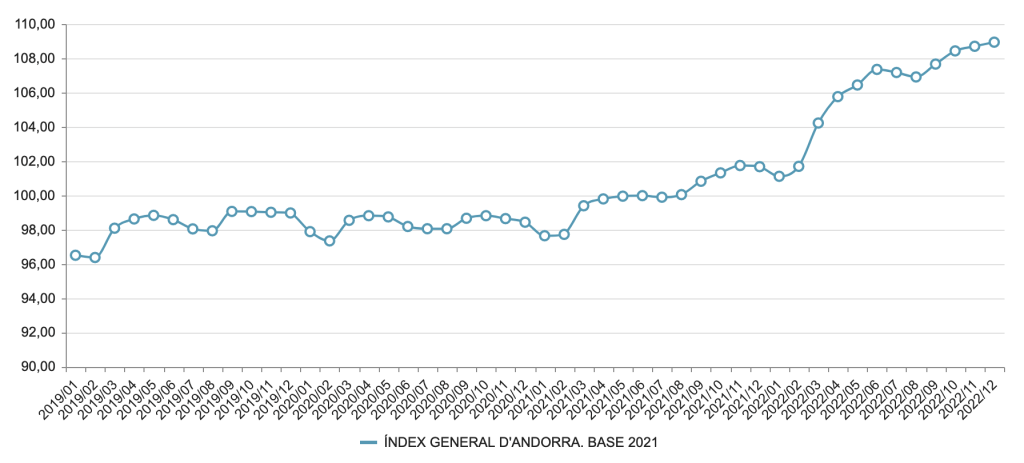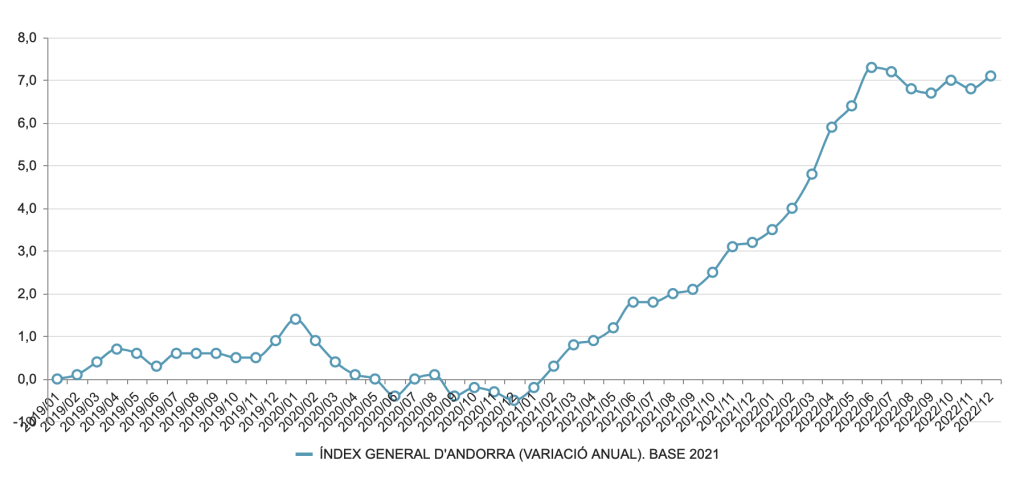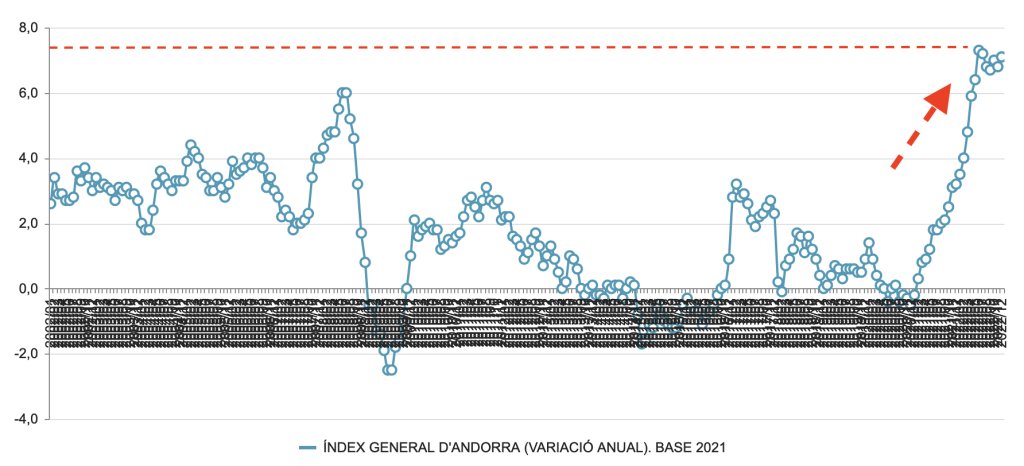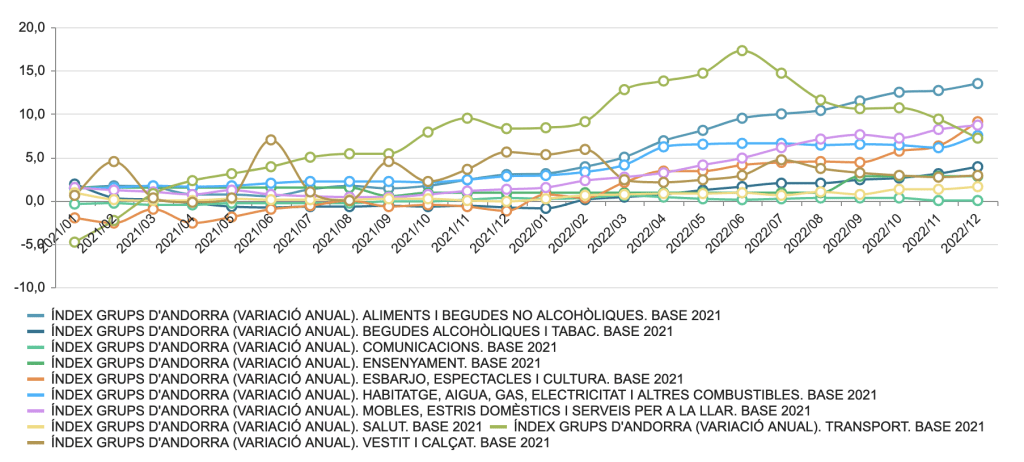Inflation in Andorra is not an exception. Since mid-2021, the CPI and prices around the world and especially in Europe and the United States began to skyrocket uncontrollably and continuously. First they told us that it was temporary, then that it was due to bottlenecks, also that it was due to the economic slowdown during the pandemic, and finally that it is Putin's fault for invading Ukraine.
Politicians, central bankers included, are like this: they never admit mistakes and nothing is their fault. Everything bad that happens is the fault of an external factor and everything good that happens is thanks to them, who are the supreme saviors of humanity. That they have spent the whole decade applying the most expansive monetary policies in all of history to avoid the puncture of the bubbles that they themselves generate has nothing to do with it. Minimum and even negative interest rates, massive asset purchases and even the distribution of arbitrary checks to citizens have become the new economic normality.
In any case, they have not given a single one. Inflation continues to wreak havoc around the world at an enormous rate, despite the fact that central banks have now started raising interest rates at the fastest rate in history, as can be seen in the FRED data. And this is not the fault of politicians either, those who disregarding the potential of nuclear energy, they decided to maintain renewable energy sources in an unsustainable way with subsidies and continue to consume fossil fuels.
Of course, with resources imported from abroad so as not to feel guilty. This has led a large part of Europe to become dependent on energy with a regime as authoritarian as Russia. with all its consequences. But it's not just that: the CPI rises in all its items and also the so-called underlying inflation is doing so with increasing vigor, with which the increase in prices is clearly being transferred to the entire economy.
And how has this situation occurred in Andorra? We already mentioned that, as far as electricity is concerned, Andorran power company FEDA ended up raising its rates twice because it could no longer bear the cost pressures on its accounts. Even so, electricity is cheaper in Andorra than in all the surrounding countries due to its peculiarities. But as we say, prices have not only increased in electricity and energy. Well, in this article let's see how inflation has evolved in the Principality.
Evolution of the CPI and inflation rate in Andorra
Below we can see the evolution of the CPI and the annual inflation rate in Andorra, according to the data shown by the Department of Statistics of the Government of Andorra for the last three years:


As we can see in the graph above, the CPI has not stopped rising steadily, especially from the beginning of 2021. The CPI is the Consumer Price Index, which in Andorra is named as a general index, and is a measure of the average increase in prices in the country. Thus, the general price index has gone from 100 around 2021 (since it is the base) to 108.94 at the end of 2022, which as we will now see fits with the annual price increase that is being experienced.
Inflation, for its part, measured annually, was stable between 0% and 1% from 2019 to early 2021, at which time it began to increase and skyrocket to around 7%. It is also quite remarkable that it has stalled around 7% and is not going down, despite the monetary restriction policies, the resolution of the supposed "bottlenecks" and the entrenchment of the war in Ukraine. Throughout 2022 it has remained at that figure.
This is the highest inflation in the entire historical record that Andorra has. said record dates back to early 2002, which is the time when the euro began to circulate as currency in Spain and France and became the de facto currency of Andorra. Below we show a graph of the entire record of the price variation, and as we can see the current rise is even higher than that which occurred at the peak of the real estate bubble where there was a price rise of 6% per year:

If we separate it by categories or groups, we see in the graph how it is obvious that at the beginning where there was more inflation is in transport, with a rate of up to 17.3% (light green line) followed by food and non-alcoholic beverages with 9.5% (dark blue line) and the group of "household, water, gas, electricity and other fuels" with 6.6% (light blue line). This is also problematic since the cost that most influences the live in Andorra is the living place.

However, since mid-2022, the rise in the transport CPI has moderated greatly to 7.2% but the other categories have continued to rise strongly, even more than before. Specifically, food and beverages have closed the year at 13.5% per year, followed by "shows, recreation and culture" that have hit a good rise at 9.3%, "furniture, household utensils and household services" with 8.7% or "household costs" with 7.5%. Not only that, categories that previously had no inflation are beginning to take off.
In the same way, if we see the price variation data broken down into the groups offered by Andorra's statistics and we take the items with the highest price increase, we observe that while "transportation services" are being deflated almost 50% and "goods and services related to vehicles" have moderated their inflation, practically all other categories are still in inflation and more and more.
"Electricity, gas and other fuels" rise again to 36.6%, for example, "durable products for recreation and culture" are placed at 16.6%, preschool and primary education at 13.6% or the «tools and other materials» are planted at 12.2%. Clearly inflation is entrenched in other sectors of the economy, just as many economists warned, for having been too high for too long. For this reason, despite the fact that gasoline and transport services fall, the same rate continues to be maintained.

So clearly It looks like we're going to have problems in the future and that for now, despite the fact that gasoline and fuel prices have moderated, electricity continues to increase in price at an exorbitant rate. This, together with the fact that the increase in the CPI is spreading to all sectors of the economy, indicates that we are likely to face a future scenario of stagflation and a price-wage spiral with recession included. A whole explosive cocktail that, of course, will also affect Andorra.
Recession in sight...
The Government of Andorra anticipated that in 2022 there would be an inflation of 4.5% and finally it has been 7.1%, thus exceeding the expectations generated. In addition, he believes that it will be much lower than 2% in the next 5 years. Something that, although they sell it as positive expectations, seem difficult to meet or indicate the opposite. Central banks like the Federal Reserve (FED) in the United States and the European Central Bank (ECB) in Europe interest rates are rising to their highest rate in history after having increased the money supply with an intensity also unprecedented in history.
The United States has already entered a technical recession and everything indicates that the economy is going to be stagnant or even contracting in the coming years. And furthermore, it doesn't seem that inflation is subsiding at a high enough rate either. The war between Russia and Ukraine has also become entrenched and if we add to that the bursting of the terrible Chinese real estate bubble, the truth is that the future points to a strong economic crisis occurring soon. While this reduces inflationary tensions, stagflation and inflationary spiral can very easily occur.






2 thoughts on “IPC e inflación en Andorra: tasa, gráficos e índice”
Agrairia si em poguesiu dir the percentage of CPI since gen 2013.
Molt agraït.
greetings
Hi Jose, many thanks for commenting.
Pots see the data with these links. But it is the annual dada, això yes.
As you will check, the inflation will be: